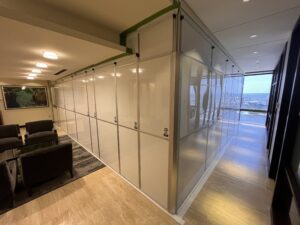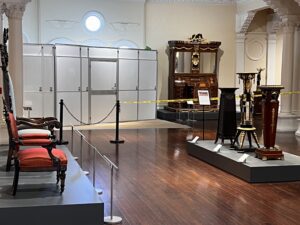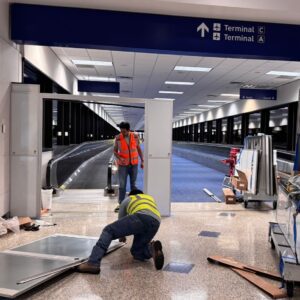Controlling Dust vs. Controlling Noise: Temporary Walls Systems
Construction projects, renovations, and industrial operations create significant challenges for facility managers. Dust particles contaminate air quality while excessive noise disrupts daily operations. Traditional solutions often address these issues separately, requiring multiple installations and increased costs. Dual-purpose temporary walls offer a comprehensive solution that tackles both dust and noise control simultaneously.
This innovative approach transforms how facilities manage environmental hazards during construction and renovation projects. By understanding the benefits and applications of these modular wall systems, facility managers can enhance safety standards while optimizing operational efficiency and cost-effectiveness.
Understanding the Hazards: Why Dust and Noise Control Matter
Dust exposure poses serious health risks in construction and renovation environments. Fine particulate matter can cause respiratory irritation, aggravate existing conditions like asthma, and contribute to long-term health complications. The Occupational Safety and Health Administration (OSHA) maintains strict guidelines for airborne dust levels, particularly for silica and other harmful particles.
Noise pollution creates equally significant challenges. Prolonged exposure to construction noise can lead to hearing damage, increased stress levels, and reduced productivity. Healthcare facilities face particularly acute concerns, as patient recovery requires quiet environments. Educational institutions struggle to maintain learning environments when construction noise interrupts classes.
These hazards compound in active facilities where ongoing operations must continue during construction or renovation work. Hospitals cannot pause patient care, schools must maintain class schedules, and office buildings need to preserve business continuity. Effective containment becomes essential for both regulatory compliance and operational success.
Traditional Solutions and Their Limitations
Conventional dust control methods typically involve plastic sheeting, negative air machines, and sealed barriers. While these approaches contain airborne particles, they often lack structural integrity and professional appearance. Plastic barriers tear easily, require frequent replacement, and create unsightly work environments.
Standard noise control solutions include sound blankets, acoustic barriers, and temporary partitions. These methods reduce sound transmission but offer limited dust containment capabilities. Installing separate systems for dust and noise control doubles material costs, extends setup time, and complicates project coordination.
Traditional approaches also present flexibility challenges. Fixed barriers cannot accommodate changing project requirements or equipment access needs. Facility managers must plan around rigid installations, potentially disrupting workflows or delaying project timelines. The lack of integration between dust and noise control systems creates gaps in protection and increases maintenance requirements.
The Rise of Temporary Walls
Temporary wall systems have evolved to address multiple environmental concerns simultaneously. Modern modular walls integrate acoustic properties with dust containment features, creating comprehensive barriers that protect against both hazards. These systems combine engineered panels, secure connections, and professional-grade materials to deliver superior performance.
The construction industry’s demand for efficient, cost-effective solutions drives innovation in temporary wall technology. Facility managers seek systems that minimize disruption while maximizing protection. Dual-purpose walls meet these requirements by combining functionality, reducing installation time, and providing flexible configurations.
Advanced temporary walls feature sound-absorbing materials, tight sealing systems, and modular components that adapt to various project requirements. These systems maintain structural integrity throughout extended installations while providing consistent protection against dust migration and noise transmission.
Noise and Dust Benefits of Temporary Walls
Cost-Effectiveness and Resource Optimization
Dual-purpose temporary walls eliminate the need for separate dust and noise control installations. This consolidation reduces material costs, labor expenses, and project coordination requirements. Facility managers can allocate budgets more efficiently by investing in comprehensive solutions rather than multiple specialized systems.
The rental model for temporary walls further enhances cost-effectiveness. Rather than purchasing equipment that may have limited future use, facilities can access professional-grade systems when needed. This approach eliminates storage requirements, maintenance costs, and capital investment concerns.
Enhanced Installation Efficiency
Modular wall systems streamline installation processes through engineered components and standardized procedures. Professional installation teams can establish comprehensive barriers quickly, reducing disruption to ongoing operations. The integrated approach eliminates coordination challenges between separate dust and noise control installations.
Quick setup capabilities prove particularly valuable in healthcare and educational environments where time constraints are critical. Facilities can implement protection measures rapidly, allowing construction or renovation work to proceed without extended operational disruptions.
Superior Flexibility and Adaptability
Temporary walls offer exceptional configuration flexibility through modular components and adjustable features. Facilities can modify barrier layouts to accommodate changing project requirements, equipment access needs, or space utilization changes. This adaptability ensures continuous protection throughout dynamic construction environments.
The reusable nature of quality temporary walls supports multiple applications across different projects. Facilities can leverage these systems for various renovation phases, emergency repairs, or seasonal maintenance activities. This versatility maximizes the value of the investment while providing consistent environmental protection.
Environmental Responsibility
Modern temporary walls support sustainability goals through reusable materials and extended service life. Rather than generating waste through disposable barriers, facilities can implement environmentally responsible solutions that align with green building objectives. The durability of professional-grade systems reduces replacement frequency and material consumption.
Quality temporary walls also contribute to improved indoor air quality by maintaining effective dust containment throughout project durations. This performance supports occupant health and wellness initiatives while demonstrating environmental stewardship.
Professional Appearance and Facility Image
Temporary walls maintain professional aesthetics that reflect facility standards and organizational values. Unlike makeshift barriers or industrial-grade partitions, these systems present clean, finished appearances that preserve the facility’s image during construction activities.
The professional presentation becomes particularly important in customer-facing environments such as retail spaces, healthcare facilities, or corporate offices. Maintaining visual standards while implementing necessary construction work demonstrates attention to detail and operational excellence.


